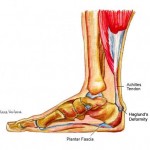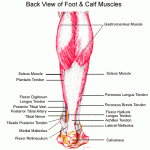Heel pain is one of the most common forms of foot pain in adults. It often occurs as a result of daily activities and exercise. The heel bone (calcaneus) is the largest bone in the foot and the heel is the first part of the foot to contact the ground during walking.
Two structures located on the bottom (sole) of the foot are primarily associated with heel pain: the plantar fascia, a band of fibrous connective tissue, and the flexor digitorum brevis muscle, which supports the arch and flexes the four small toes.
Normally, as the foot absorbs the weight of the body during walking, the arch area joint locking mechanism provides about 80% of the stability of the foot. The other 20% of biomechanical stability is provided by the plantar fascia and muscles, tendons, and ligaments. (See Anatomy of the Foot and Ankle).
Gait abnormalities can cause inflammation of the structures attached to the heel bone, resulting in heel pain. Inflammation of the plantar fascia, called plantar fasciitis, is the most common cause of heel pain.
Plantar fasciitis often causes pain that is more severe following a period of rest (e.g., after sleeping). This condition is also called post-static dyskinesia, which means “pain after rest.”
Sometimes, muscle strain and tension pull at the origin site on the bottom surface of the heel bone producing an inflammatory response that begins making new bone. This interim condition is called periostitis. The forming bone spur grows forward in the direction of this pulling. Heel spurs can irritate nerves and cause pain.
Incidence and Prevalence of Heel Pain
Heel pain is most common in active people over the age of 40. This increased prevalence may result from a decrease in the elasticity of the plantar fascia and a slowing of the healing process with age. Heel pain also is relatively common in active children and adolescents between the ages of 8 and 13. Pediatric heel pain frequently occurs on the bottom rear of the heel or the sides.
Heel pain occurs in both heels (bilaterally) in less than 30 percent of cases. The left heel is commonly the first to be affected. The opposite heel may follow with similar symptoms, often as a result of compensation.



